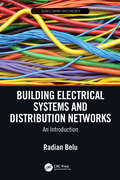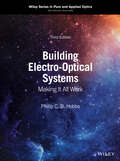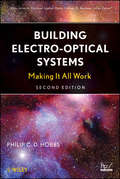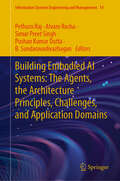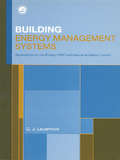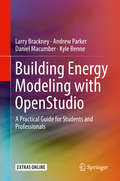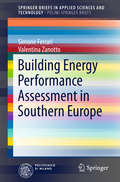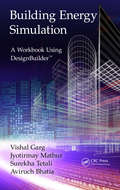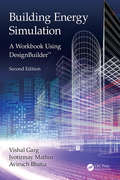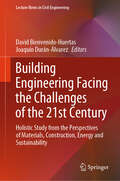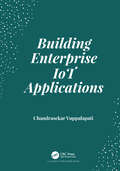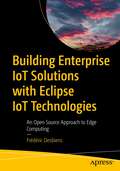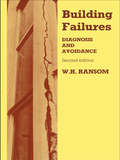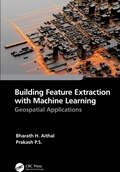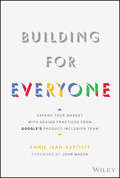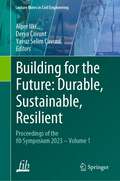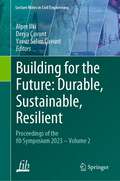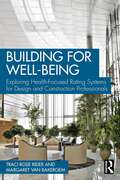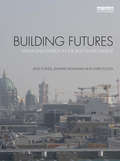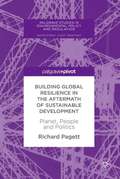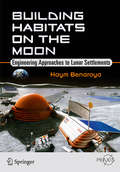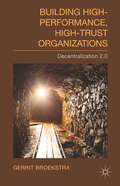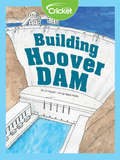- Table View
- List View
Building Electrical Systems and Distribution Networks: An Introduction (Nano and Energy)
by Radian BeluThis book covers all important, new, and conventional aspects of building electrical systems, power distribution, lighting, transformers and rotating electric machines, wiring, and building installations. Solved examples, end-of-chapter questions and problems, case studies, and design considerations are included in each chapter, highlighting the concepts, and diverse and critical features of building and industrial electrical systems, such as electric or thermal load calculations; wiring and wiring devices; conduits and raceways; lighting analysis, calculation, selection, and design; lighting equipment and luminaires; power quality; building monitoring; noise control; building energy envelope; air-conditioning and ventilation; and safety. Two chapters are dedicated to distributed energy generation, building integrated renewable energy systems, microgrids, DC nanogrids, power electronics, energy management, and energy audit methods, topics which are not often included in building energy textbooks. Support materials are included for interested instructors. Readers are encouraged to write their own solutions while solving the problems, and then refer to the solved examples for more complete understanding of the solutions, concepts, and theory.
Building Electro-Optical Systems: Making It All Work (Wiley Series in Pure and Applied Optics #28)
by Philip C. HobbsBuilding Electro-Optical Systems In the newly revised third edition of Building Electro-Optical Systems: Making It All Work, renowned Dr. Philip C. D. Hobbs delivers a birds-eye view of all the topics you’ll need to understand for successful optical instrument design and construction. The author draws on his own work as an applied physicist and consultant with over a decade of experience in designing and constructing electro-optical systems from beginning to end. The book’s topics are chosen to allow readers in a variety of disciplines and fields to quickly and confidently decide whether a given device or technique is appropriate for their needs. Using accessible prose and intuitive organization, Building Electro-Optical Systems remains one of the most practical and solution-oriented resources available to graduate students and professionals. The newest edition includes comprehensive revisions that reflect progress in the field of electro-optical instrument design and construction since the second edition was published. It also offers approximately 350 illustrations for visually oriented learners. Readers will also enjoy: A thorough introduction to basic optical calculations, including wave propagation, detection, coherent detection, and interferometers Practical discussions of sources and illuminators, including radiometry, continuum sources, incoherent line sources, lasers, laser noise, and diode laser coherence control Explorations of optical detection, including photodetection in semiconductors and signal-to-noise ratios Full treatments of lenses, prisms, and mirrors, as well as coatings, filters, and surface finishes, and polarization Perfect for graduate students in physics, electrical engineering, optics, and optical engineering, Building Electro-Optical Systems is also an ideal resource for professional designers working in optics, electro-optics, analog electronics, and photonics.
Building Electro-Optical Systems
by Philip C. HobbsPraise for the First Edition"Now a new laboratory bible for optics researchers has joined the list: it is Phil Hobbs's Building Electro-Optical Systems: Making It All Work."--Tony Siegman, Optics & Photonics NewsBuilding a modern electro-optical instrument may be the most interdisciplinary job in all of engineering. Be it a DVD player or a laboratory one-off, it involves physics, electrical engineering, optical engineering, and computer science interacting in complex ways. This book will help all kinds of technical people sort through the complexity and build electro-optical systems that just work, with maximum insight and minimum trial and error.Written in an engaging and conversational style, this Second Edition has been updated and expanded over the previous edition to reflect technical advances and a great many conversations with working designers. Key features of this new edition include:Expanded coverage of detectors, lasers, photon budgets, signal processing scheme planning, and front endsCoverage of everything from basic theory and measurement principles to design debugging and integration of optical and electronic systemsSupplementary material is available on an ftp site, including an additional chapter on thermal Control and Chapter problems highly relevant to real-world designExtensive coverage of high performance optical detection and laser noise cancellationEach chapter is full of useful lore from the author's years of experience building advanced instruments. For more background, an appendix lists 100 good books in all relevant areas, introductory as well as advanced. Building Electro-Optical Systems: Making It All Work, Second Edition is essential reading for researchers, students, and professionals who have systems to build.
Building Embodied AI Systems: The Agents, the Architecture Principles, Challenges, and Application Domains (Information Systems Engineering and Management #14)
by Pethuru Raj Alvaro Rocha Simar Preet Singh Pushan Kumar Dutta B. SundaravadivazhaganThis book is primed to demystify the emerging and evolving trend of embodied systems. It explains how these unique systems facilitate establishing smarter environments such as multi-specialty hospitals, manufacturing floors, warehouses, retail stores, defense zones, eating joints, entertainment plazas, etc., in detail for the benefit of our esteemed readers. To get a complete and actionable understanding of any mission-critical environment, we must deploy embodied systems. These systems, such as robots, drones, etc., are physical entities that are embedded and empowered with software systems. They interact with the environment in real time, providing context-aware services. There are chapters exclusively delineating the technologies behind the realization and deployment of such enigmatic systems. The prominent industrial use cases are explained in the latter chapters.
Building Energy Management Systems: An Application to Heating, Natural Ventilation, Lighting and Occupant Satisfaction
by Geoff LevermoreEnergy management systems are used to monitor building temperature inside and outside buildings and control the boilers and coolers. Energy efficiency is a major cost issue for commerce and industry and of growing importance on university syllabuses. Fully revised and updated, this text considers new developments in the control of low energy and HVAC systems and contains two new chapters. Written for practising engineers (essential for control engineers) and energy managers in addition to being essential reading for under/postgraduate courses in building services and environmental engineering.
Building Energy Modeling with OpenStudio: A Practical Guide For Students And Professionals
by Andrew Parker Larry Brackney Daniel Macumber Kyle BenneThis textbook teaches the fundamentals of building energy modeling and analysis using open source example applications built with the US DOE’s OpenStudio modeling platform and EnergyPlus simulation engine. Designed by researchers at US National Laboratories to support a new generation of high performance buildings, EnergyPlus and OpenStudio are revolutionizing how building energy modeling is taught in universities and applied by professional architects and engineers around the world. The authors, all researchers at National Renewable Energy Laboratory and members of the OpenStudio software development team, present modeling concepts using open source software that may be generally applied using a variety of software tools commonly used by design professionals. The book also discusses modeling process automation in the context of OpenStudio Measures—small self-contained scripts that can transform energy models and their data—to save time and effort. They illustrate key concepts through a sophisticated example problem that evolves in complexity throughout the book. The text also examines advanced topics including daylighting, parametric analysis, uncertainty analysis, design optimization, and model calibration. Building Energy Modeling with OpenStudio teaches students to become sophisticated modelers rather than simply proficient software users. It supports undergraduate and graduate building energy courses in Architecture, and in Mechanical, Civil, Architectural, and Sustainability Engineering.
Building Energy Performance Assessment in Southern Europe (SpringerBriefs in Applied Sciences and Technology)
by Simone Ferrari Valentina ZanottoThis book discusses the issues relevant to the evaluation of the thermal energy balance of buildings in southern Europe and equips readers to carry out optimal building energy-performance assessments taking into account the peculiarities of the climatic context. Evaluation of building energy performance in this region is complex, since the significant need for cooling means that the effect of thermal capacity, glazed surfaces and ventilation and shading strategies have to be carefully considered when determining the indoor operative temperatures. This is fully explained, and critical issues in the application of the commonly employed, simplified procedures and assumptions are identified. In addition to the theoretical analysis, there are case studies that explore the energy performances of a set of typical building typologies within the variability of the Italian climate, considered as representative of conditions in southern Europe. These descriptions will support energy consultants and other stakeholders in assessing building energy performances beyond the mere simplified standard assumptions. Furthermore, the numerous graphs and tables documenting data canbe easily adopted to serve as design advice tools for both new constructionsand retrofits.
Building Energy Simulation: A Workbook Using DesignBuilder™
by Aviruch Bhatia Jyotirmay Mathur Surekha Tetali Vishal GargThis book describes various components and systems of a building and their effect on energy consumption, with the help of an energy simulation tool. The book explains simulation input parameters, along with how to do analysis of the simulation output. With minimal use of mathematical equations, the basics of building physics and energy simulation are explained using words, illustrative examples, charts, tables, and figures.
Building Energy Simulation: A Workbook Using DesignBuilder™
by Vishal Garg Jyotirmay Mathur Aviruch BhatiaThe second edition of Building Energy Simulation includes studies of various components and systems of buildings and their effect on energy consumption, with the help of DesignBuilderTM, a front-end for the EnergyPlus simulation engine, supported by examples and exercises. The book employs a "learning by doing" methodology. It explains simulation-input parameters and how-to-do analysis of the simulation output, in the process explaining building physics and energy simulation. Divided into three sections, it covers the fundamentals of energy simulation followed by advanced topics in energy simulation and simulation for compliance with building codes and detailed case studies for comprehensive building energy simulation. Features: Focuses on learning building energy simulation while being interactive through examples and exercises. Explains the building physics and the science behind the energy performance of buildings. Encourages an integrated design approach by explaining the interactions between various building systems and their effect on energy performance of building. Discusses a how-to model for building energy code compliance including three projects to practice whole building simulation. Provides hands-on training of building energy simulation tools: DesignBuilder™ and EnergyPlus. Building Energy Simulation is intended for students and researchers in building energy courses, energy simulation professionals, and architects.
Building Engineering Facing the Challenges of the 21st Century: Holistic Study from the Perspectives of Materials, Construction, Energy and Sustainability (Lecture Notes in Civil Engineering #345)
by David Bienvenido-Huertas Joaquín Durán-ÁlvarezBuilding engineering is a complex and constantly evolving branch. The needs of the XXI century society cause a constant change in construction industry due to the need to achieve sustainable and ecological buildings. This affects all levels and phases of this engineering. Given this circumstance, numerous researchers turn their efforts to find optimal solutions for building engineering. For this reason, in this book a holistic analysis of building engineering is carried out from the perspectives that have a greater weight for sustainability objectives. The book is divided into 6 sections: (i) Building materials, which deals with research related to the most innovative and sustainable building materials; (ii) Design and construction, which deals with existing methodologies and advances in design and construction in construction sector; (iii) Building repair and maintenance, which deals with building repair, maintenance and upkeep techniques; (iv) Energy efficiency, which analyses the latest research on the energy efficiency of buildings and their behaviour in the face of climate change; (v) Sustainability, which analyses the establishment of measures to achieve a more sustainable built environment; and (vi) construction management, which compiles the latest studies in the field of Project manager. The 38 chapters of the book together constitute an advance for the topic of building engineering. The aspects covered in the book are of great interest to various sectors, such as researchers, engineers, architects, legislators and interested parties.
Building Enterprise IoT Applications
by Chandrasekar VuppalapatiMcKinsey Global Institute predicts Internet of Things (IoT) could generate up to $11.1 trillion a year in economic value by 2025. Gartner Research Company expects 20 billion inter-connected devices by 2020 and, as per Gartner, the IoT will have a significant impact on the economy by transforming many enterprises into digital businesses and facilitating new business models, improving efficiency and increasing employee and customer engagement. It’s clear from above and our research that the IoT is a game changer and will have huge positive impact in foreseeable future. In order to harvest the benefits of IoT revolution, the traditional software development paradigms must be fully upgraded. The mission of our book, is to prepare current and future software engineering teams with the skills and tools to fully utilize IoT capabilities. The book introduces essential IoT concepts from the perspectives of full-scale software development with the emphasis on creating niche blue ocean products. It also: Outlines a fundamental full stack architecture for IoT Describes various development technologies in each IoT layer Explains IoT solution development from Product management perspective Extensively covers security and applicable threat models as part of IoT stack The book provides details of several IoT reference architectures with emphasis on data integration, edge analytics, cluster architectures and closed loop responses.
Building Enterprise IoT Solutions with Eclipse IoT Technologies: An Open Source Approach to Edge Computing
by Frédéric DesbiensBuild IoT solutions for the enterprise using open-source building blocks from the Eclipse IoT Working Group at the Eclipse Foundation. This book introduces you to key protocols and their implementations, such as CoAP (Eclipse Californium), DDS (Eclipse Cyclone DDS), LwM2M (Eclipse Leshan), and MQTT (Eclipse Paho, Eclipse Mosquitto, and Eclipse Amlen). You will learn about Edge Computing platforms (Eclipse ioFog, Eclipse Kanto), IoT gateways (Eclipse Kura, Eclipse Kapua), and next-generation edge native protocols (Eclipse zenoh).The book also covers production-ready platforms for digital twins (Eclipse Ditto), energy management (Eclipse VOLTTRON), contactless payments (Eclipse Keyple), and much more.Although the book discusses hardware matters, its focus is on software and relevant open standards. The book helps you understand the pros and cons of the technologies available from Eclipse IoT and how they have been used in actual deployments. The examples provided cover a variety of use cases, such as industrial automation, smart agriculture, digital buildings, robotics, and others.The book's contents follow a reference architecture encompassing constrained devices (things), edge devices (gateways, servers), and IoT Cloud platforms. For each of those three pillars, you will learn about relevant open-source components. Usage of code libraries and frameworks is explained through code samples. You will also learn how to deploy and configure platform-type components and how to leverage them. Special attention will be paid to security and edge computing throughout the book. What You Will LearnDescribe in your own words the main software components required in an IoT architectureSelect the appropriate IoT protocols, components, frameworks, and platforms for a specific projectEvaluate the connectivity options at your disposal and select the most appropriate onesExplain the value of business models focused on open-source components and deploy such models in your organizationDetermine if edge computing is relevant to a project and deploy the relevant components on an edge computing platformBuild Enterprise IoT solutions leveraging an array of open-source components and platforms using popular languages such as C, Java, and RustWho This Book Is ForDevelopers new to enterprise IoT who want to learn about fundamental technologies for that market segment and seek an introduction to relevant, open-source building blocks; experienced IoT developers who seek alternatives to the proprietary platforms they are currently using; software architects designing IoT solutions who want to understand open-source technology options
Building Failures: Diagnosis and avoidance
by W. H. RansomIn recent years building failures and the resulting lawsuits and awards for damages have frequently been in the news. The biggest headlines may have been reserved for structural failures and complete collapses, but we should not forget the less newsworthy failures such as leaky roofs, damp walls, dropped foundations and rotted timber. This book gives practical guidance on the prevention of failure by describing the nature and cause of the most common defects in buildings, and then shows how they should be avoided in design and construction.
Building Feature Extraction with Machine Learning: Geospatial Applications
by Bharath.H. Aithal Prakash P.S.Big geospatial datasets created by large infrastructure projects require massive computing resources to process. Feature extraction is a process used to reduce the initial set of raw data for manageable image processing, and machine learning (ML) is the science that supports it. This book focuses on feature extraction methods for optical geospatial data using ML. It is a practical guide for professionals and graduate students who are starting a career in information extraction. It explains spatial feature extraction in an easy-to-understand way and includes real case studies on how to collect height values for spatial features, how to develop 3D models in a map context, and others. Features Provides the basics of feature extraction methods and applications along with the fundamentals of machine learning Discusses in detail the application of machine learning techniques in geospatial building feature extraction Explains the methods for estimating object height from optical satellite remote sensing images using Python Includes case studies that demonstrate the use of machine learning models for building footprint extraction and photogrammetric methods for height assessment Highlights the potential of machine learning and geospatial technology for future project developments This book will be of interest to professionals, researchers, and graduate students in geoscience and earth observation, machine learning and data science, civil engineers, and urban planners.
Building For Everyone: Expand Your Market With Design Practices From Google's Product Inclusion Team
by Annie Jean-BaptisteDiversity and Inclusion to build better products from the front lines at Google Establishing diverse and inclusive organizations is an economic imperative for every industry. Any business that isn’t reaching a diverse market is missing out on enormous revenue potential and the opportunity to build products that suit their users' core needs. The economic “why” has been firmly established, but what about the “how?” How can business leaders adapt to our ever-more-diverse world by capturing market share AND building more inclusive products for people of color, women and other underrepresented groups? The Product Inclusion Team at Google has developed strategies to do just that and Building For Everyone is the practical guide to following in their footsteps. This book makes publicly available for the first time the same inclusive design process used at Google to create user-centric award-winning and profitable products. Author and Head of Product Inclusion Annie Jean-Baptiste outlines what those practices look like in industries beyond tech with fascinating case studies. Readers will learn the key strategies and step-by-step processes for inclusive product design that limits risk and increases profitability. Discover the questions you should be asking about diversity and inclusion in your products for marketers, user researchers, product managers and more. Understand the research the Product Inclusion team drove to back up their practices Learn the “ABCs of Product Inclusion” to build inclusion into your organization’s culture Leverage the product inclusion suite of tools to get your organization building more inclusively and identifying new opportunities. Read case studies to see how product inclusion works across industries and learn what doesn't work. Building For Everyone will show you how to infuse your business processes with inclusive design. You’ll learn best practices for inclusion in product design, marketing, management, leadership and beyond, straight from the innovative Google Product Inclusion team.
Building for the Future: Proceedings of the fib Symposium 2023 - Volume 1 (Lecture Notes in Civil Engineering #349)
by Alper Ilki Derya Çavunt Yavuz Selim ÇavuntThis book presents the proceedings of the fib Symposium “Building for the future: Durable, Sustainable, Resilient”, held in Istanbul, Turkey, on 5–7 June 2023. The book covers topics such as concrete and innovative materials, structural performance and design, construction methods and management, and outstanding structures. fib (The International Federation for Structural Concrete) is a not-for-profit association whose mission is to develop at an international level the study of scientific and practical matters capable of advancing the technical, economic, aesthetic, and environmental performance of concrete construction.
Building for the Future: Proceedings of the fib Symposium 2023 - Volume 2 (Lecture Notes in Civil Engineering #350)
by Alper Ilki Derya Çavunt Yavuz Selim ÇavuntThis book presents the proceedings of the fib Symposium “Building for the future: Durable, Sustainable, Resilient”, held in Istanbul, Turkey, on 5–7 June 2023. The book covers topics such as concrete and innovative materials, structural performance and design, construction methods and management, and outstanding structures. fib (The International Federation for Structural Concrete) is a not-for-profit association whose mission is to develop at an international level the study of scientific and practical matters capable of advancing the technical, economic, aesthetic, and environmental performance of concrete construction.
Building for Well-Being: Exploring Health-Focused Rating Systems for Design and Construction Professionals
by Traci Rose Rider Margaret van BakergemBuilding for Well-Being is the first introduction to health-focused building standards for design and construction professionals. More than a summary of the state of the field, this practical resource guides designers, builders, developers, and owners through considerations for incorporating WELL®, Fitwel®, and other systems from the planning phase to ground-breaking and beyond. Side-by-side comparisons of established and emerging health-focused standards empower building professionals to select the most appropriate certifications for their projects. Drawing on the authors’ backgrounds in sustainable design and public health, chapters on the evolution of the green building movement and the relationship between health and the built environment provide vital context for understanding health-focused standards and certifications. The final chapter looks toward the future of health and the built environment.
Building Futures: Managing energy in the built environment
by Jane Powell Jennifer Monahan Chris FouldsA reduction in the energy demand of buildings can make a major contribution to achieving national and international carbon reduction goals, in addition to addressing the interlinked issues of sustainable development, fuel poverty and fuel security. Despite improvements in thermal efficiency, the energy demand of buildings stubbornly remains unchanged, or is only declining slowly, due to the challenges posed by growing populations, the expectations of larger, more comfortable and better equipped living spaces, and an expanding commercial sector. Building Futures offers an interdisciplinary approach to explore this lack of progress, combining technical and social insights into the challenges of designing, constructing and operating new low energy buildings, as well as improving the existing, inefficient, building stock. The twin roles of energy efficiency, which is predominantly concerned with technological solutions, and energy conservation which involves changing peoples’ behaviour, are both explored. The book includes a broad geographical range and scale of case studies from the UK, Europe and further afield, including Passivhaus in Germany and the UK, Dongtan Eco City in China and retrofit houses in Denmark. This book is a valuable resource for students and academics of environmental science and energy-based subjects as well as construction and building management professionals.
Building Global Resilience in the Aftermath of Sustainable Development: Planet, People and Politics (Palgrave Studies in Environmental Policy and Regulation)
by Richard PagettThis book explains why the concept of sustainable development needs to be consigned to history. Using examples from around the world, Richard Pagett illustrates how so-called sustainable development has simply been a cul-de-sac, condemning millions to continuing extreme poverty. Building Global Resilience in the Aftermath of Sustainable Development highlights the futility of current governance systems in meeting modern day global challenges. It also explains the changes that are necessary for a more just and equitable economic societal model, with planetary limits at its core, to further the resilience of communities and society at large. These changes are crucial to confronting the existential threats posed by climate change, resource depletion and overpopulation. This book will be of particular interest to practitioners of environmental management and to anyone concerned for the future of the planet.
Building Green Skyscrapers (Fountas & Pinnell LLI Purple #Level V)
by Mary ReidPeople need skyscrapers. They hold hundreds of apartments and offices on a small piece of land. Instead of spreading homes, office buildings, and parking lots over acres of forest or prairie, skyscrapers leave much more of the natural world untouched.
Building Habitats on the Moon: Engineering Approaches to Lunar Settlements (Springer Praxis Books)
by Haym BenaroyaDesigning a habitat for the lunar surface? You will need to know more than structural engineering. There are the effects of meteoroids, radiation, and low gravity. Then there are the psychological and psychosocial aspects of living in close quarters, in a dangerous environment, far away from home. All these must be considered when the habitat is sized, materials specified, and structure designed. This book provides an overview of various concepts for lunar habitats and structural designs and characterizes the lunar environment - the technical and the nontechnical. The designs take into consideration psychological comfort, structural strength against seismic and thermal activity, as well as internal pressurization and 1/6 g. Also discussed are micrometeoroid modeling, risk and redundancy as well as probability and reliability, with an introduction to analytical tools that can be useful in modeling uncertainties.
Building Hawaii’s Innovation Economy: Summary of a Symposium
by Charles W. WessnerResponding to the challenges of fostering regional growth and employment in an increasingly competitive global economy, many U. S. states and regions have developed programs to attract and grow companies as well as attract the talent and resources necessary to develop innovation clusters. These state and regionally based initiatives have a broad range of goals and increasingly include significant resources, often with a sectoral focus and often in partnership with foundations and universities. These are being joined by recent initiatives to coordinate and concentrate investments from a variety of federal agencies that provide significant resources to develop regional centers of innovation, business incubators, and other strategies to encourage entrepreneurship and high-tech development. Building Hawaii's Innovation Economy: Summary of a Symposium explains the study of selected state and regional programs in order to identify best practices with regard to their goals, structures, instruments, modes of operation, synergies across private and public programs, funding mechanisms and levels, and evaluation efforts. This report reviews selected state and regional efforts to capitalize on federal and state investments in areas of critical national needs. Building Hawaii's Innovation Economy also reviews efforts to strengthen existing industries as well as specific new technology focus areas such as nanotechnology, stem cells, and energy in order to better understand program goals, challenges, and accomplishments.
Building High-Performance, High-Trust Organizations: Decentralization 2.0
by Gerrit BroekstraSome vanguard companies have evolved to a higher level of decentralization originating in the enabling-and-autonomy paradigm. A new kind of deep leadership is practiced by these spirit-driven organizations. This book brings together theory and case studies to cover historical origins and developments of both types of decentralization.
Building Hoover Dam
by Liz HuyckHave you ever wondered how the Hoover Dam was built? Follow along as the Colorado River itself tells you its story! A lot of work went into the construction of this giant dam, but it was worth it—we now have Lake Mead and a way of converting the river’s energy into electricity!
